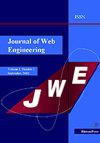Fort2BCK:通过区块链加强医疗保健环境中的签名
IF 1
4区 计算机科学
Q4 COMPUTER SCIENCE, SOFTWARE ENGINEERING
引用次数: 0
摘要
本研究介绍了Fort2BCK,这是一种高级安全框架,旨在缓解医疗保健区块链实施中的关键漏洞,特别是数据操纵、未经授权的访问和共识协议中的弱点。Fort2BCK采用双重验证机制,将本地共识算法验证与高级加密签名(RSA, ECDSA和零知识证明,zkp)的应用相结合,从而提供了额外的认证,审计和抵抗恶意攻击的层。与传统方法相比,Fort2BCK通过在将每个块集成到区块链之前对其进行独立的加密验证,从而显著降低了欺诈和伪造的风险,从而增强了传统共识模型可能容易受到攻击的情况下的安全性。此外,它与多个区块链架构的互操作性,包括工作量证明(PoW),权益证明(PoS)和委托权益证明(DPoS),使其能够通过集成的外部验证层有效减轻攻击,例如PoW中的51%攻击和PoS中的无利害问题。为了评估Fort2BCK的有效性,在一个具有100个节点和50,000个事务的模拟混合区块链网络上进行了实验。结果显示,与传统的区块链系统相比,Fort2BCK在抵御块重写攻击方面的安全性提高了35%,欺诈交易率降低了42%,同时计算开销保持在8%以下。此外,Fort2BCK确保遵守HIPAA和GDPR等法规,确保医疗保健行业的区块链系统满足法律和隐私要求。这些发现表明,Fort2BCK优化了医疗区块链的安全性、可扩展性和隐私性,促进了医疗系统的安全数字化,并加强了对临床数据管理的信任。本文章由计算机程序翻译,如有差异,请以英文原文为准。
Fort2BCK: Fortifying Signatures in Healthcare Environments Through Blockchain
This study introduces Fort2BCK, an advanced security framework designed to mitigate critical vulnerabilities in healthcare blockchain implementation, specifically data manipulation, unauthorised access and weaknesses in consensus protocols. Fort2BCK employs a dual verification mechanism, combining native consensus algorithm validation with the application of advanced cryptographic signatures (RSA, ECDSA and zero knowledge proofs, ZKPs), thus providing an additional layer of authentication, auditing and resistance to malicious attacks. In contrast to traditional approaches, Fort2BCK significantly reduces the risks of fraud and forgery by independently cryptographically verifying each block before it is integrated into the blockchain, strengthening security in scenarios where conventional consensus models may be vulnerable. In addition, its interoperability with multiple blockchain architectures, including proof of work (PoW), proof of stake (PoS) and delegated proof of stake (DPoS), allows it to effectively mitigate attacks such as the 51% attack in PoW and the nothing-at-stake problem in PoS, through an integrated external validation layer. To evaluate the effectiveness of Fort2BCK, experiments were conducted on a simulated hybrid blockchain network with 100 nodes and 50,000 transactions. The results revealed that Fort2BCK increases security by 35% against block rewrite attacks and decreases the rate of fraudulent transactions by 42%, compared to conventional blockchain systems, while maintaining a computational overhead of less than 8%. Additionally, Fort2BCK ensures compliance with regulations such as HIPAA and GDPR, ensuring that blockchain systems for the healthcare sector meet legal and privacy requirements. These findings demonstrate that Fort2BCK optimises the security, scalability and privacy of medical blockchains, facilitating the secure digitisation of healthcare systems and strengthening trust in clinical data management.
求助全文
通过发布文献求助,成功后即可免费获取论文全文。
去求助
来源期刊

Journal of Web Engineering
工程技术-计算机:理论方法
CiteScore
1.80
自引率
12.50%
发文量
62
审稿时长
9 months
期刊介绍:
The World Wide Web and its associated technologies have become a major implementation and delivery platform for a large variety of applications, ranging from simple institutional information Web sites to sophisticated supply-chain management systems, financial applications, e-government, distance learning, and entertainment, among others. Such applications, in addition to their intrinsic functionality, also exhibit the more complex behavior of distributed applications.
 求助内容:
求助内容: 应助结果提醒方式:
应助结果提醒方式:


